In this post I want to take you off the beaten track and to some less well explored, more exotic, remote locations. The eight selected places have only one thing in common: they are all islands. Other than that they are very different from each other and represent a range of distinct categories of dark tourism that dark globe trotters visit for very different reasons.
Of course there are well-known dark islands, too, such as Alcatraz or Robben Island, both former prison islands turned memorials, which today attract large numbers of visitors and hence overlap with mainstream tourism; but here we are going to get further away from that.
The first place is the Falkland Islands, or Las Malvinas as they’re known in Latin America. This year marks the 40th anniversary of the war that Britain went to with Argentina in 1982 to wrestle the archipelago back from Argentine occupation. I went there shortly after the 30th anniversary in 2013/14.
Here’s a photo of the main liberation memorial in the islands’ capital Port Stanley:

The road behind this monument, by the way, is called Thatcher Drive, and indeed Margaret Thatcher is disproportionately more revered in the Falklands than at home in Britain.
Tourism in the Falklands is comparatively small-scale and comes in basically two forms: wildlife watching (penguins in particular) and battlefield tourism. And that is of course part of dark tourism. Battlefield tourism in turn comes in two forms: for people who have a personal connection to the war, had relatives fighting in it, say, a trip to the Falklands is something like a pilgrimage (and I met such visitors when I was there). For others, like myself, it’s just an interest in war history as such and a desire to experience being in the actual authentic locations – what has been dubbed ‘place authenticity’. And that is a very important aspect of dark tourism, of course.
On sparsely populated West Falkland my host in Port Howard took me on a battlefield tour which included sites where Argentine fighter jets crashed after having been shot down by the British in the 1982 war. The British plane wrecks have all been cleared away but the Argentine ones are still in place, such as this one, with a mangled jet engine:

Here’s a whole cockpit section of another plane wreck:

.
Other war relics include various Argentine positions, abandoned guns, field kitchens and so on and so forth. And speaking of kitchens, in one of the various small museums about the Falklands War you can find these original Argentine provisions:

You can make out tins of sausages (“Wieners”) and meatballs, and the miniature bottle in the foreground was filled with Argentine-made whisky, but ironically with the English name “The Breeder’s Choice” (probably to make it look like Scotch).
.
Leaving behind the Falklands and moving north in the South Atlantic there’s another British overseas territory: St Helena, a rocky, formerly volcanic island 1200 miles (2000 km) off the mainland of southern Africa, more precisely the Namibian/Angolan coast (same photo as featured at the top of this post):
.

St Helena is best known for having been the final place of exile of Napoleon Bonaparte, and it’s also where he died in 1821. The Napoleon-related sights on St Helena are a key aspect of the island’s very small tourism industry. They can be considered a mix of grave tourism and cult-of-personality tourism. Napoleon’s original grave is this:
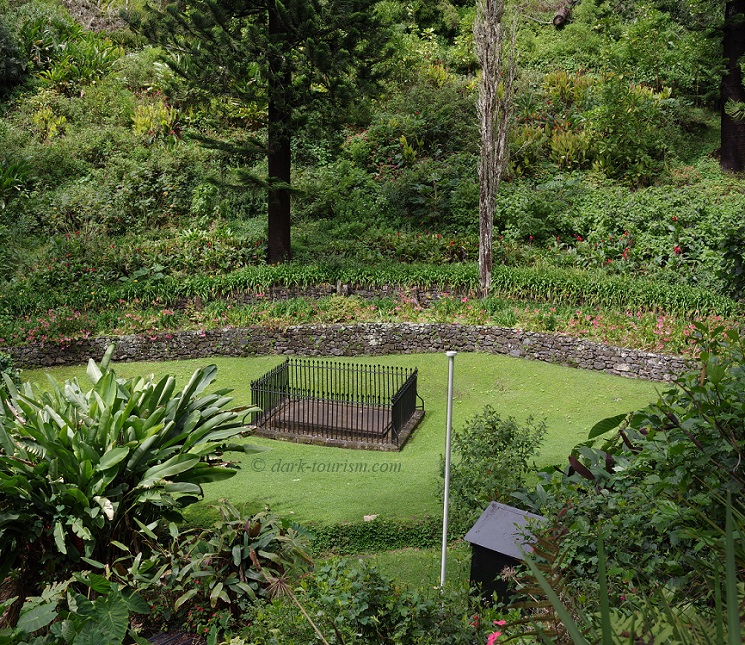
This is empty these days, though, and has been since Napoleon’s body was taken back to France in 1840, but anyway, the original grave is still a tourist attraction.
Yet the main point of interest in this context is Longwood House, where Napoleon lived in exile and where he died. This is his deathbed and a death mask is on display too:
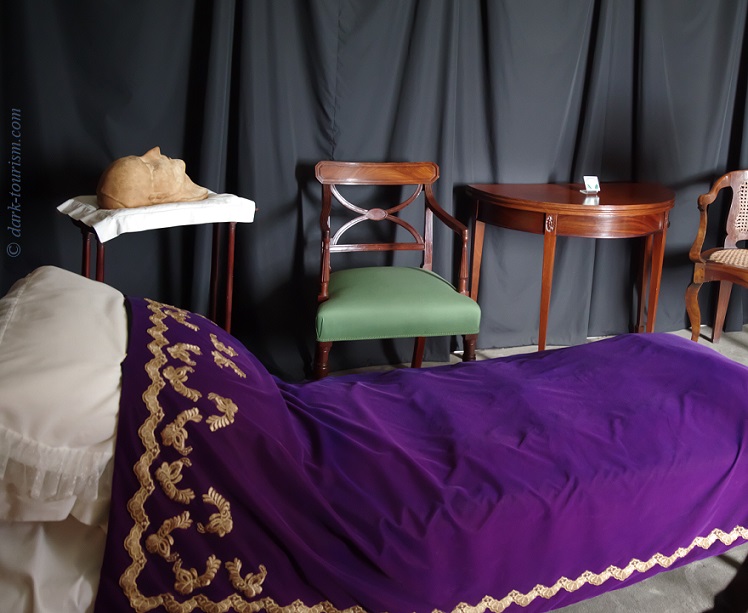
There were other exiles on St Helena, e.g. from the Zulu and Boer Wars in South Africa, and from 1957 to 1962 three nationalist rebels from Bahrain were housed in a now abandoned building overlooking Rupert’s Bay:

.
Moving into the northern hemisphere: to the island of Montserrat in the West Indies. This has been dubbed “the Pompeii of the Caribbean”, due to the volcanic catastrophe that from the mid-1990s destroyed the island’s capital Plymouth, covering it in layers and layers of volcanic ash from pyroclastic flows and lahars. And this makes it a dark-tourism attraction, namely in the category of (natural) disaster tourism.
Here’s an image of Plymouth seen from a boat in late 2009:
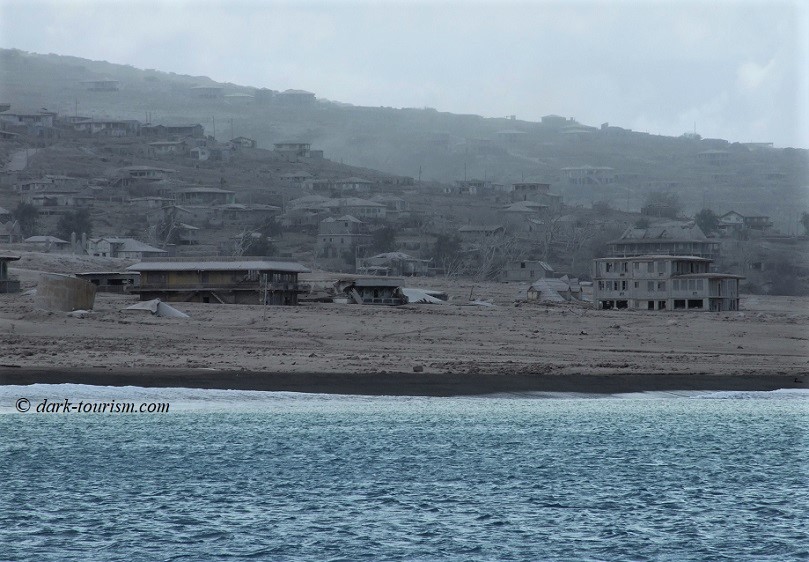
I visited the island during the latest major eruptive phase, and access to Plymouth on foot was forbidden. On the other hand, the volcano’s activity provided a dark show of its own at the time. And it was the only time I ever witnessed a pyroclastic surge:

This photo was taken from a safe viewpoint at the Montserrat Volcano Observatory (MVO) several miles away on an opposite hillside. So it was far less dangerous than it might look.
And at night the volcano offered an eerie glow, seen from the same spot:

.
Now from the tropics to the high Arctic … namely to Spitsbergen, the main island of the Svalbard archipelago. This is located halfway between northern Norway and the North Pole. Politically the islands belongs to Norway, but in accordance with the 1920s Svalbard Treaty, the Soviet Union was granted continued coal-mining rights on Spitsbergen. This led to the odd situation that the USSR had outposts on a territory that belonged to a NATO member state … although: the islands themselves were demilitarized according to the treaty.
There is still an active Russian coal mining settlement on Spitsbergen, namely Barentsburg, but the key attraction from a dark-tourism perspective is the abandoned mining ghost town of Pyramiden, seen here:

Spitsbergen’s tourist infrastructure includes organized excursions to Pyramiden, where a rump staff from Russia still look after a small part of the settlement and even run a hotel (although it is unclear whether these tours are available in the current situation with the war in Ukraine and the consequent isolation of Russia in the Western world …). The type of dark-tourism this falls under is what has been dubbed Soviet tourism – a kind of virtual time travel back to the Cold-War era, but not within the actual former Soviet Union or the Eastern Bloc, but in this remote outpost … against this Arctic backdrop:
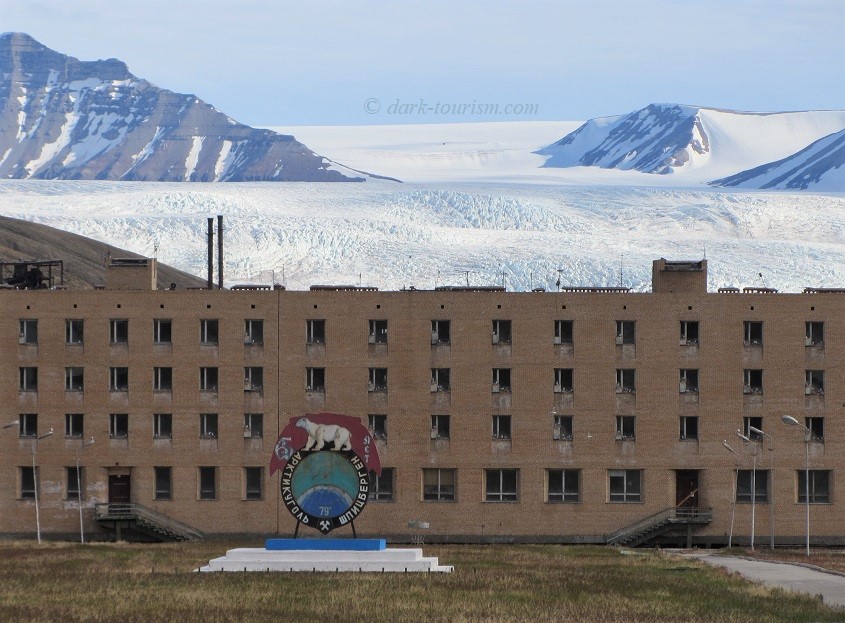
The highlight from a dark-tourism perspective is a visit to the former Gagarin cultural centre, where you also find the world’s northernmost Lenin bust:

Poking around this centre is a delight not unlike visiting the most famous dark ghost town, Pripyat in the Chernobyl exclusion zone.
But now to the Mediterranean, more precisely the Adriatic and an infamous island off the coast of Croatia: Goli Otok. In the Yugoslav era, this served as a prison island, and became known as the “Croatian Alcatraz” or “Tito’s Gulag”. The prison was finally closed in the late 1980s and has been largely abandoned ever since.

And here’s one from the main street of the area with the forced-labour workshops on Goli Otok:
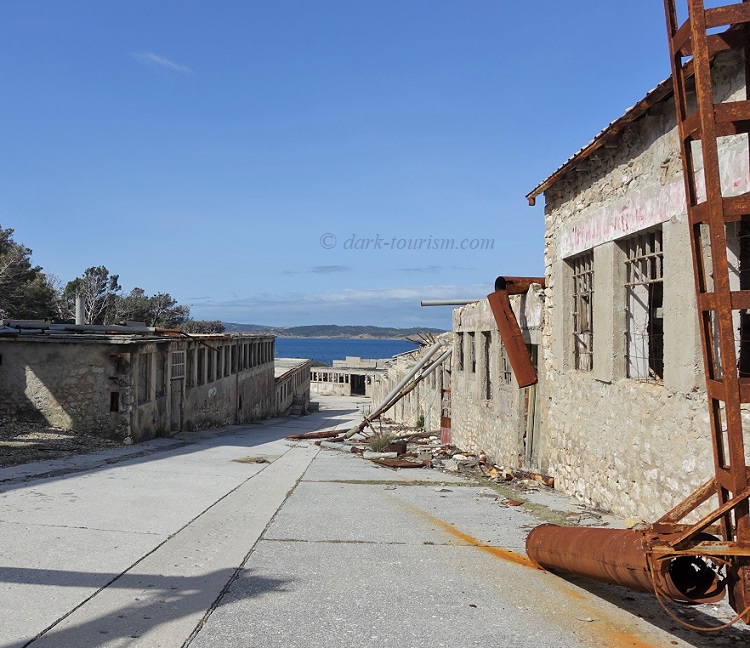
And here’s one taken inside the former infirmary – with an old rusty X-ray machine still in place:

In terms of dark tourism this falls under both urbex (urban exploration – of abandoned places) and prison tourism, in part also communism tourism because of the Tito connection. Goli Otok is also a case where dark tourism and mainstream tourism meet – in the most bizarre fashion: In season there are boat excursions from the neighbouring beach holiday island of Rab, and on Goli Otok visitors are taken round in one of those electric tractor-pulled tourist trains that are the ultimate hallmark of mainstream tourism. But instead I went off season so had to hire a boat with a skipper to take me across to Goli Otok where I had three hours before being picked up again. But for that time my wife and I had the entire island all to ourselves.
But now to Asia, namely Japan, and another unique oddity: Okunoshima, also known as “Rabbit Island”. In his 2018 book “I am the Dark Tourist” author Howard Sawyer called this a “juxtaposition of dark tourism and cute tourism” (p.187). Why “cute tourism”? Because the majority of tourists come to see scenes like this:
.

.
Indeed, Okunoshima is home to hundreds of feral rabbits and people come to enjoy their presence and feed them. But amongst all this cuteness, the island holds a very dark, sinister secret: during WWII it was the site of a secret chemical weapons lab and production facility of the Japanese Imperial Army. It was cleared up after the war, but some relics are still visible, such as this site of a former poison gas storage container:

.
The largest relic here is the former power station, now an empty shell:

.
So again we have an element of urbexing involved here again. Otherwise it’s a niche subset of WWII tourism, one you could call WMD tourism even. There’s also a privately run “Poison Gas Museum” that recounts the dark history of the island.
It’s rather unusual in Japan to find the country’s dark history during WWII so openly commodified, and it’s telling that this was made possible only through a private grass-roots initiative without any state funding.
Another example of such private initiatives is also the small Oka Masaharu Memorial Peace Museum in Nagasaki that covers the history of Japanese war crimes, including the exploitation of Korean and Chinese prisoners of war for forced labour.
One place where these poor people were forced to do dangerous and hard labour was in the coal mines underneath Hashima Island. This is also known as Gunkanjima, or “Battleship Island”, due to its silhouette from afar:

The coal mines continued operations, without prisoners, after the war but were closed in the 1970s. After that, the settlement, once the most densely populated spot on the planet, was abandoned. Today Hashima is a ghost island, and its structures are crumbling:
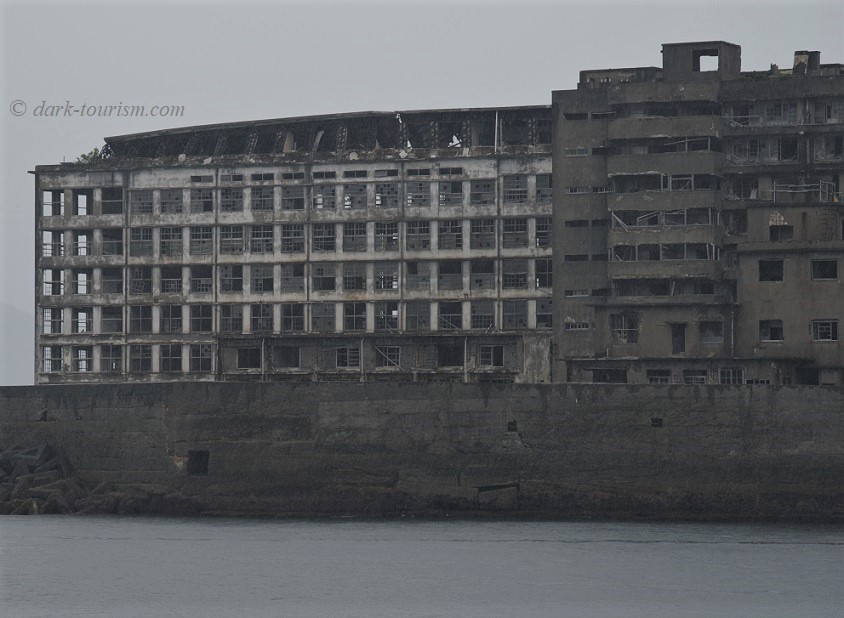
The island came to international fame thanks to a James Bond Movie (”Skyfall”, 2012), in which it was the secret den of a typical Bond villain. Since 2015 Hashima has been a World Heritage Site, but not for its dark aspects, only as an example of Japan’s industrial and cultural heritage. There are tourist boat tours to the island from Nagasaki. I joined one in 2019, during rather bad weather, as you can see here:

These excursions are in fact very touristy indeed, with a guide delivering a narration through a microphone to tourists wearing headsets:

BUT: there is absolutely no mention of POWs and forced labour, instead it’s like a whitewash. So unless you come pre-prepared, or have been to the small private war crimes museum beforehand, you wouldn’t know about anything dark here. So, arguably, going on these Hashima tours can only count as dark tourism if you’ve done your homework in advance. But I’ve often claimed that such preparation ahead of travel is important for most of dark tourism, if you want to take it seriously.
Finally, a brief mention of Easter Island, the world’s most remote inhabited island. This is famous mostly for it giant rock statues called moai, such as this reconstructed one:

They go back to a high culture that suffered societal collapse after overpopulation and overexploitation of the available resources led to a toppling of the old rule, a civil war, and famine. There may even have been cannibalism. In the course of this societal collapse, all the moai, which were symbols of the previous ruling class, were all toppled. So when the European explorers and colonizers arrived, they found the moai in this state:

It was only later when Europeans became fascinated with the collapsed ancient culture that several of the moai were re-erected. The largest number of them at Ahu Tongariki:

Now the dark connection here is not so much that of the historic societal collapse, but the fact that it can be seen as a warning, on a smaller scale, of what now applies to the whole world today. Overexploitation of resources is now happening globally and is threatening the survival of humankind. This has been dubbed “Easter Island Syndrome”. So visiting Easter Island, even though this aspect doesn’t openly feature in the tourism industry there, again includes a very dark aspect, but you only get that if you come pre-prepared. It’s only abstract, but as I say in the final line of my book, just as the Easter Islanders had to learn the hard way that there was no other island to evacuate to, the people of planet Earth now have to learn that there is no “Planet B” (an expression you can often encounter at climate change demonstrations).
[Please note: this post is an adaptation of a presentation I gave at the “Visiting the Shadows” conference in Prague in early May this year, an event organized under the “Progressive Connexions” umbrella. And since no publication prospects have ever come from this conference, I feel free to reuse my own content here, slightly adapted for the written form, and with photos trimmed and adapted to this Blog’s format too.]




3 responses
The conference was a merged event that brought several conference topics together, as too few participants were prepared to attend a live event again, for fear of Corona, for them to be feasible as stand-alone conferences. Hence the ever more merged conference ended up the most interdisciplinary event I have ever encountered, by an enormous margin. On the topic of dark tourism there were only a small handful of presentations, the other themes ranged from street art to queerness, and from film to witchcraft (seriously!) and there was lots of sex and violence thrown in for good measure too. Suddenly dark tourism seemed not a niche but a rather benign mainstream topic! But, even though some topics were rather outlandish from my perspective, it was an enjoyable and horizon-broadening event. For instance, I would never have thought I’d thoroughly enjoy a workshop on “Poetry and Disaster”, in which participants were asked to write down their own ad hoc poetry! Normally such a prompt would trigger resistance on my part, but there I found myself engaged in it, it felt good and the results were not too bad. Maybe I’ll disclose some of my improvised poetic efforts with a DT theme from that event on this platform at some point …
Bougainville deserves to be here as well.
I agree, if that was to be a complete list … and then there would also have to be East Timor, Fogo, Iceland, South Georgia, the Channel Islands, Ilha do Tigres, Mudyuk, Andaman, Cuba, Gruinard, Brioni, Nauru, Tristan da Cunha, Bikini, Tinian, White Island, Green Island, Kinmen, Yaros, Mikronisos, Devil’s Island, Goree, Okinawa etc., etc., etc.
BUT: this was for a 20-minute presentation, so I had to be selective. Had I been given two or better twenty hours I could have been more comprehensive. But given the time constraints I selected those islands that were less well known than Alcatraz or Robben Island but from where I had good photos in my own travel photo archives. Bougainville is still on my wishlist, i.e. I’ve not been there yet, so I wouldn’t have any photos from there.
Btw. do you know the novel “Mister Pip” by Lloyd Jones that is set on Bougainville? If not do get yourself a copy. It’s fabulous (but tough at times, content-wise … very dark).